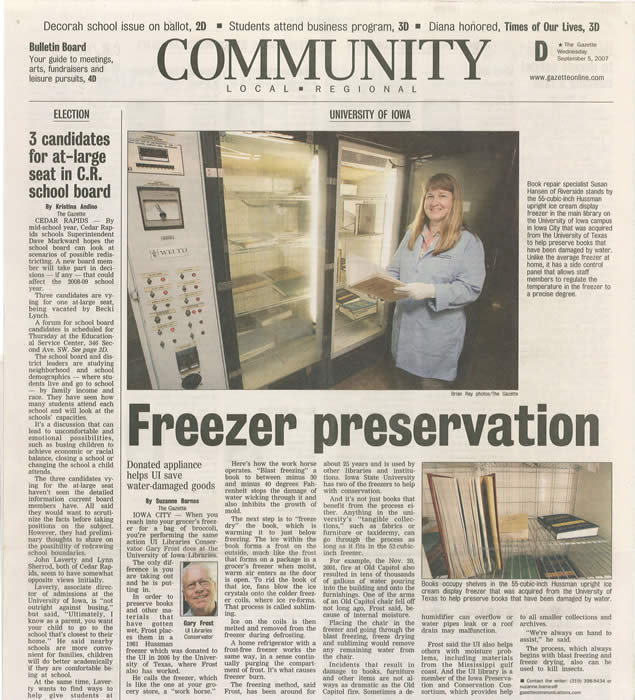Freezer preservation
Donated appliance helps UI save water-damaged goods
By Suzanne Barnes
The Gazette
IOWA CITY — When you reach into your grocer’s freezer for a bag of broccoli, you’re performing the same action UI Libraries Conservator Gary Frost does at the University of Iowa Libraries. The only difference is you are taking out and he is putting in. In order to preserve books and other materials that have gotten wet, Frost places them in a 1981 Hussman freezer which was donated to the UI in 2006 by the University of Texas, where Frost also has worked. He calls the freezer, which is like the one at your grocery store, a “work horse.” Here’s how the work horse operates. “Blast freezing” a book to between minus 30 and minus 40 degrees Fahrenheit stops the damage of water wicking through it and also inhibits the growth of mold. The next step is to “freeze dry” the book, which is warming it to just below freezing. The ice within the book forms a frost on the outside, much like the frost that forms on a package in a grocer’s freezer when moist, warm air enters as the door is open. To rid the book of that ice, fans blow the ice crystals onto the colder freezer coils, where ice re-forms. That process is called subliming. Ice on the coils is then melted and removed from the freezer during defrosting. A home refrigerator with a frost-free freezer works the same way, in a sense continually purging the compartment of frost. It’s what causes freezer burn. The freezing method, said Frost, has been around for about 25 years and is used by other libraries and institutions. Iowa State University has two of the freezers to help with conservation. And it’s not just books that benefit from the process either. Anything in the university’s “tangible collections,” such as fabrics or furniture or taxidermy, can go through the process as long as it fits in the 52-cubic-inch freezer. For example, the Nov. 20, 2001, fire at Old Capitol also resulted in tens of thousands of gallons of water pouring into the building and onto the furnishings. One of the arms of an Old Capitol chair fell off not long ago, Frost said, because of internal moisture. Placing the chair in the freezer and going through the blast freezing, freeze drying and subliming would remove any remaining water from the chair. Incidents that result in damage to books, furniture and other items are not always as dramatic as the Old Capitol fire. Sometimes a dehumidifier can overflow or water pipes leak or a roof drain may malfunction. Frost said the UI also helps others with moisture problems, including materials from the Mississippi gulf coast. And the UI library is a member of the Iowa Preservation and Conservation Consortium, which provides help to all smaller collections and archives. “We’re always on hand to assist,” he said. The process, which always begins with blast freezing and freeze drying, also can be used to kill insects.
Contact the writer: (319) 398-8434 or suzanne.barnes@ gazettecommunications.com
